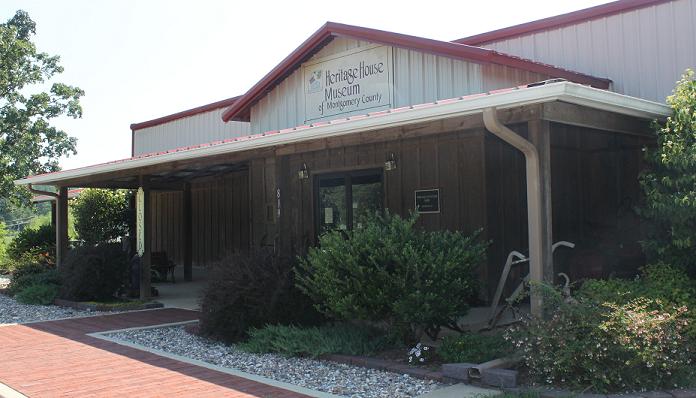
Heritage Day - a living history event is Saturday Memorial weekend
The Heritage House Museum is a public museum and research library with outdoor living history grounds. An unique holding of the museum is the fabric collection room in which to store locally historic quilts and blankets. One of the museum goal's is to become a research center especially for genealogists. The Heritage House Museum, established in 1998, and is taking submissions of family history, copies of photos of family, etc. Every community and settlement, every family will have something of interest to put into the history of the county. Facebook, The museum has the Dick Whittington tapes as well as the Barbara Holt interviews she did in 1981 with some Montgomery County residents that covered living conditions, foods, health etc. and recorded individuals: Una Bates, Ola Mae Walton, Dick Whittington, Lula Liles Hickey, the Sheffield sisters (Bonez Short, Rhea Tidwell and Nagene Carr), Lottie Stanley and Lena Lenderman Irby as well as information on Home Economics class in high school, Home Demonstration Club and 4-H Club. Many old b/w photos from county residents have been scanned it and available to view on the museums computer thanks to volunteers. Open Tuesday - Fri. 9 -4, Sat. & Sun. 1 - 4. Closed Mondays.

Heritage Day - a living history event is Saturday
Memorial weekend
On the way back through Mt Ida, 22 May 2009, we stopped at the Heritage House Museum as it was the opening of the Exhibit Barn. The museum now has an original log cabin and men where working on securing the foundation with rocks. They plan to build a chimney. Outside there were live exhibits – hominy was boiling, beans were cooking in a huge black cast iron kettle on an open fire, a treasured heirloom, blacksmiths working, men whittling. Inside the museum were exhibits featuring the whittling of Audie Shaw and the fiddle carving tools of Wash Brumley (b. 1874) (s/o Joshua and Rebecca Jane Crawford Brumley from TN and Georgia respectively). At the County Fair in August 2009 Mary Black won the award for Best in Show in the Heirloom Exhibit (the keepsake item must be at least 50 years old with a certain beauty, uniqueness, interesting history or just sentimental value) for her grandfather Lon Jones' fiddle, which was carved by Wash Brumley from Alamo in the early 1900s. Wash's daughter was there at the museum – the incredible Violet Brumley Hensley, b. 21 Oct. 1916, playing her own hand made fiddle, an Arkansas Living Treasure. It was a pleasure to hear. She is now 92. She grew up about 2½ miles from Alamo. She married Adren Hensley in 1935 when she was 18 and had nine children. She had on the table one of her own fiddles beautifully carved with head of a horse at the end where you tune. What is the difference between a violin and a fiddle? Is it just the way it is played? Fiddling is fast. She played “Going Up Brushy Fork” for me. There was also a fiddle on display, had carved by a Lybrand family member. Ladies from the Pine Ridge EH Club where quilting a friendship quilt to be giving as a gift to the Mt Ida EH representative as she is leaving the area and all of the EH clubs created blocks with signatures of the members embroidered. It is going to be a lovely gift. My mother in-law's name was there, she actually did the quilt squares for the Oden EH club. There was lye soap, old postcards, jam and Mrs Hensley’s CDs for sale. The blueprints for the barn are not for sale, I have already asked. Betty Prince and Glenna Lybrand were on the front porch of the museum dressed in period costume making butter and knitting. The exhibit barn had a variety of miscellaneous tools and static exhibits rooms off the center bay replicating a tack room, crib, tool shed and blacksmith shop. In an additional side room, and pieces of equipment are on display. e.g. carpenter’s chest and tools, apple cider press, sickles and scythes, etc. and many tools I did not recognise. They need to be labeled.
26th May 2012 was a hot day- re-actors on 4th annual Heritage Day- wearing jean wool trousers.
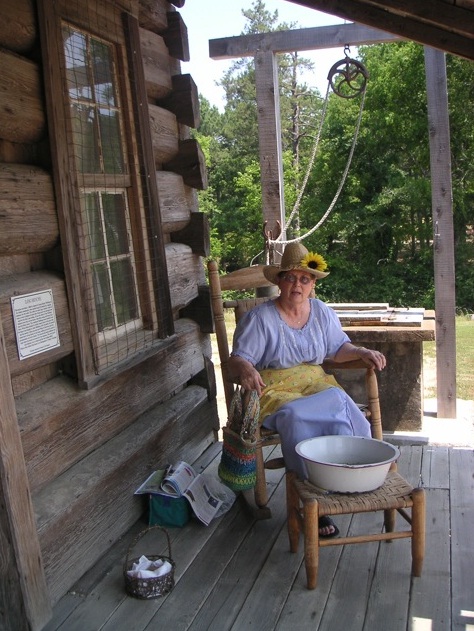
Heritage Day 26 May 2012, snapping green beans. Too hot, only 82F at 11 am but by 5 pm it was 89F!
Bump Rocker was made from red oak with seats made from white strips. The Bump's made their own splits with trees found around the area. The Bump chairs have fine cuts in them where their finishing nails on a straight board makes marks on the wood. The tendon outside edge slightly larger than the shoulder. The rungs are kiln dry and the posts you put them in are half dry, and when the wood shrinks down you can hardly take it apart. You want to dry some so the wood won't crack. Fred's dad Philander and Great Grandpa Wiley Rouse also made chairs in Bear. Fred Oliver Bump made chairs until a couple of years before he passed away in 1977. He was good turning wood on the lathe. His son Dallas took over the chair making business. Dallas O. Bump died at 98. His nephew Leon still carries on the family business in 2021. The woman weaved the seats and backs. Takes an hour and a half to weave a seat. The family has been making chairs in Bear since the 1870s.
The museum has at least six signature quilts.
Heritage House Museum Exhibit Barn - opening day 22 May 2009. "The barn was patterned off an old barn in the south part of the county and serves to emphasize the various types of work that might have taken place in various barns throughout Montgomery County. Corn would have been stored there to keep dry. A person might have done blacksmithing there as well as for his neighbors, who were not equipped or skilled. A work shed, the site of many tasks, would certainly have occupied part of the barn. Much time and hard work was spent in the barn of our past. A family's horses, mules, wagons and gear would have been tendered there. The barn was the work center of the old home place." The idea for the design came from a similar barn in the southern part of the county. Behind the barn is the log cabin recently, 2009, moved from Alamo, that is in the process of being restored.
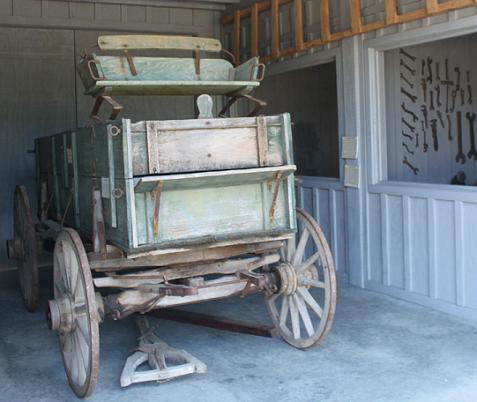
This authentic log house from the Alamo area was donated by Pat and Wayne Hopper to the museum and recently moved to the site. Mullings & Milholen cabin. The owner of the cabin in 1904 was Susan Mullings. Susan and her first husband, Samuel Mullings, lived in the home with five children, until his death. Susan then married Rayburn "Rabe" Jones, and his two children came along with him to live there. The home w as purchased by the Milholen family in the 1930s and five out of seven children were born in the home. The property stayed in the Milholen family until it was purchased by Wayne Hopper. It took 2½ hours to move the house to the museum via Logan's Rd. The roof was been reconstructed and the porch added. The house was originally just one main room. One room has been left in its original condition and the other decorated with a bed and other period furnishings.
Inside the log house mason jar lids were nailed to the wall to hold on newspaper
dated from 1940.
There was no real insulation back in those days. It was very common to line the
walls with newspaper. That was cheap insulation. They were not log cabins but
board cabins. The alterative was to live out in the woods with a rawhide
tent.
Mrs Violet Brumley Hensley at opening day for the exhibit barn 22 May 2009.
Nominated Arkansas Living Treasure in 2004. Born at Alamo in Oct. 1916,
delivered by a midwife, now 92.
The log cabin she was born in burnt down when the family was away in Oklahoma
and teh Preasley's were living there. They had a chimney fire. The Brumleys
returned and lived with an Uncle until the house was rebuilt across the road.
Her mother was a Springer from Crystal Springs. She use to make her own fiddles and dresses and whittle.
See the one with the horse head on the table. The museum has a child size fiddle
made by Wash for the daughter of Joe Simpson, Mary Jo Flatte. Joe was
Violet's first and last teacher at the Alamo School. Wash made his
first fiddle in 1888 at the age of 14. He used crude methods to make the
fiddles, he would press the fiddle into shape with nails, and dressed out a cat
for the strings. He made and sold and played violins but the farm supported the
family. There is a photo in "Our Heritage, Volume Two" of Wash playing one of
his handmade violins with just a splinter of wood. Violet started playing at
square dances when she was 13. Folks would come over to their home, there would
be a house, on a Saturday night, full until about 9pm. "Nine o'clock nothing
said go to bed." Wash, Violet and another
daughter who played guitar would provide music for country dances. The old
time tune ROSE NELL, was one of the first tunes Violet Hensley played on the
fiddle. Violet learned from her father, George Washington “Wash” Brumley when
she was age 12 in 1928.
Violet raised a family of nine with her late husband Adren Hensley. She joined
the crafter’s cast at Silver Dollar City in Branson, Missouri in 1967, becoming
part of the City’s celebrities who used radio, television, and newspapers to
invite visitors to the amusement park. She could sing and play the fiddle at the
same time. Tunes she would play include: Jericho, Leather britches, Golden
slippers. Bonaparte's retreat, Mississippi sawyer, Black eyes Susie, Red wing
She made 72 fiddle's in her lifetime. 2007
Links: 1930
census
Jericho
Bio
interview
photo
family
tree
Nearby is this shed. Typical of the county with the boards vertical and the
rusty corrugated iron roof. More barns.
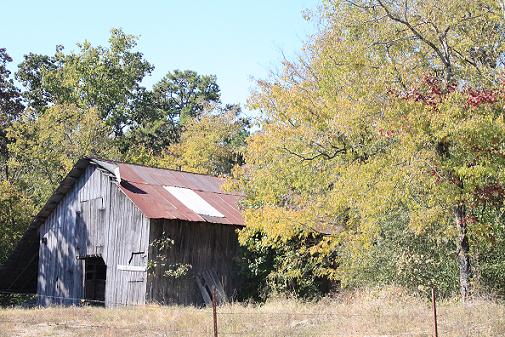
18 months later, Oct. 2010, the roof needs a few nails.
A Museum's Director's Day - could be any museum
A lot of our work is project based, and is why no day is ever the same. A project might be working on an exhibition that's yet to be mounted. Sometimes, one of us will take control of the whole exhibition. Sometimes it's a team effort with different people taking different responsibilities. My role is to do some of the research, move things along, act as a resource person, agree to any expenditure. There's a lot of work involving administration with time sheets, city council regulations, health and safety, building-maintenance issues, financial reports and annual reports. A lot of my work is involved in communication dealing with the media, whether it's going to the media with a story or dealing with an inquiry, and communication with the public what the museum does, the museum piece, preparing the museum newsletter for Friends of the Museum. We also have relationships with other museums and national museum organisations. On any given day, I can be answering emails, sending information to someone. We learn from other museums and they learn from us.
Because we now have a team of people working here, a lot of my role is to work with some of those people on the different projects that they are working on, helping them get the resources they need, providing support, rather than me telling them what to do. We've got curators, educators, a part-time technician, a part-time cleaner, a fluctuating population of workers and volunteers, and we've also had our interns. So on any given day, there can be eight to ten people coming and going. Twenty years ago I was doing everything and now I'm managing other people. I still get to very occasionally keep my hand in with museum education, by acting as a relief educator. We're doing education for other counties now, and we're applying for a new grant from the Board of Education. Grant writing, getting money out of various places, is an important part of the job, whether it's the Trust or a charity. Have to consider: common pests found in museums, pest management, environmental control and monitoring. Moisture controlled display cases. Light and lighting, security systems and fire safety.
Part of the day, I'm rostered on to the front desk, answering phones, dealing with over-the-counter inquiries, dealing with objects people have bought in for the collection. It's being a point of visitor contact, which is another way of saying security. Every week, at least, we have people offering things to the museum. It might be one item or it might be the tip of an iceberg. Usually it's one or two items. It's important for the museum to actively manage what it accepts. We might already have some things. For us to want to take something, we have to be able to use and display for education purposes or for research. It could be an organ, spiders or an old dinner set. We generally focus on things that have a connection to county, and that's things from nature as well as history, some things that show how people lived their lives things that might not have great financial value, but are no longer around. The key thing is the stories around them. A collection of anonymous but beautiful things is all well and good, but we would rather have slightly damaged things with stories attached. We take an incredibly long-term view for how things will be used. Something might be used in a display 175 years from now. So we try to think, if I was a curator in 150 years, what would be a useful thing I could use? It's developing connoisseurship, getting a curator's eye for things.
Someone will come in and say, "I'm looking for my ancestor", and I'll direct them to curator in archives. Or someone comes in with a painting to identify the artist. People phone, particularly desperate parents with homework queries. People think museums are information services, and that's part of our role. One of the challenges of this job there are so many fascinating and important things we could be doing is to keep the focus realistic. We spend a reasonable amount of time dealing with those strategic issues, looking at how we can change the museum, looking at stuff that museums are doing around State and the world. We talk with community groups on site and off site. It's about communication. You can't be too shy in a job like this. People want to know what we collect, and it helps people get over the perception that it's a dusty old place you go to see once in a lifetime. It would be safe to say that the community's perceptions and use of the museum over time have changed. Hopefully, more people see the museum as a place they would want to go to. Part of it is attending meetings e.g. the historical society. At the the tail end of the day, we're usually finished up and away about 5.00pm, unless there are meetings. On Mondays, we're not open to the public. They are quite often days when we will have exhibition changes or we will also use Monday to hold staff planning meetings. If we have stuff we have to do away from the museum, we try to schedule that for a Monday, or we'll get contractors in if they need to do something noisy or messy.There are wonderful handcrafted items in Montgomery County. The museum has two apple head dolls made in the 1970s used in a Green Thumb display at conventions. There were made by Oden residents Mabel Wilkins and Ruth Perkins. One of the dolls sits in a rocking chair that was carved by Audie Shaw of Sims.
We get quite a lot of people who will pop in and say, `I think my family used to live in Mt. Ida.'. Lots of people come in who have a connection with the area. The museum can be a main draw card for people visiting the town.
Volunteers at a Museum
A museum with a tight budget needs a pool of volunteers to keep museum doors open. They take turns to meet and greet visitors at the desk. The team helps with a range of jobs such as fundraising, research, managing the historical cuttings and book catalogue, repairs and maintenance, keeping the grounds tidy and serving on the magazine or building committee. They hold an annual afternoon tea to mark Volunteer Awareness week. Volunteering had also enabled many people in the community to learn new skills. Involvement can give much delight. All of the volunteers are from the local community. Some visit to admire the various displays, while others were searching for information about their family history. ‘‘It is one reason why we have such an amazing community.’’ ‘‘If we didn’t enjoy it, we wouldn’t keep coming back.’’
For a fund raiser: The Friends of the Museum could arrange a
Sunday afternoon event and invite anyone with antique or collectable items they
want to find out more about to come to the Museum. Have a local expert on hand
to value items brought in. Cost $2 per item valued, limit of 6 items per person.
All funds go to the Friends of the Museum.
For a fund raiser: Volunteers can plant, pick and dig potatoes and peas and sell
them at the museum. Early potatoes - Victoria and the main crop Nadine.
For a fund raiser: A garden tour in early spring with the four impressive
gardens and a floral competition.
For a fund raiser: A historic film evening or slide show, a cook
book.
Deaccession: To sell (a work of art) from a museum's or gallery collections, esp. with a view to acquiring funds for the purchase of other works. The museum would have to follow a process to determine if the collection, or items from it, was of no use or further benefit to the community, or if it had multiples of items and determined if particular items were given, on loan or a permanent loan.
A key museum role is to build, preserve and make collections accessible for the future as well as for today.
Do You Just Belong?
Are you an Active Member,
The kind that would be missed,
Or are you just content
That your name is on the list?
Do you attend the meeting
And mingle with the flock,
Or do you sit at home
And criticise and knock?
Do you take an active part
To help the work along,
Or are you satisfied
To only just belong?
Do you do the part
With the hand upon the stick,
Or do you leave the work to others,
And talk about the clique?
This is over Member,
You know right from wrong;
Are you an Active Member,
Or do you just belong?
Coming together.
Coming together is a beginning;
Keeping together is progress;
Thinking together is unity.
Working together is success.
Henry Ford.
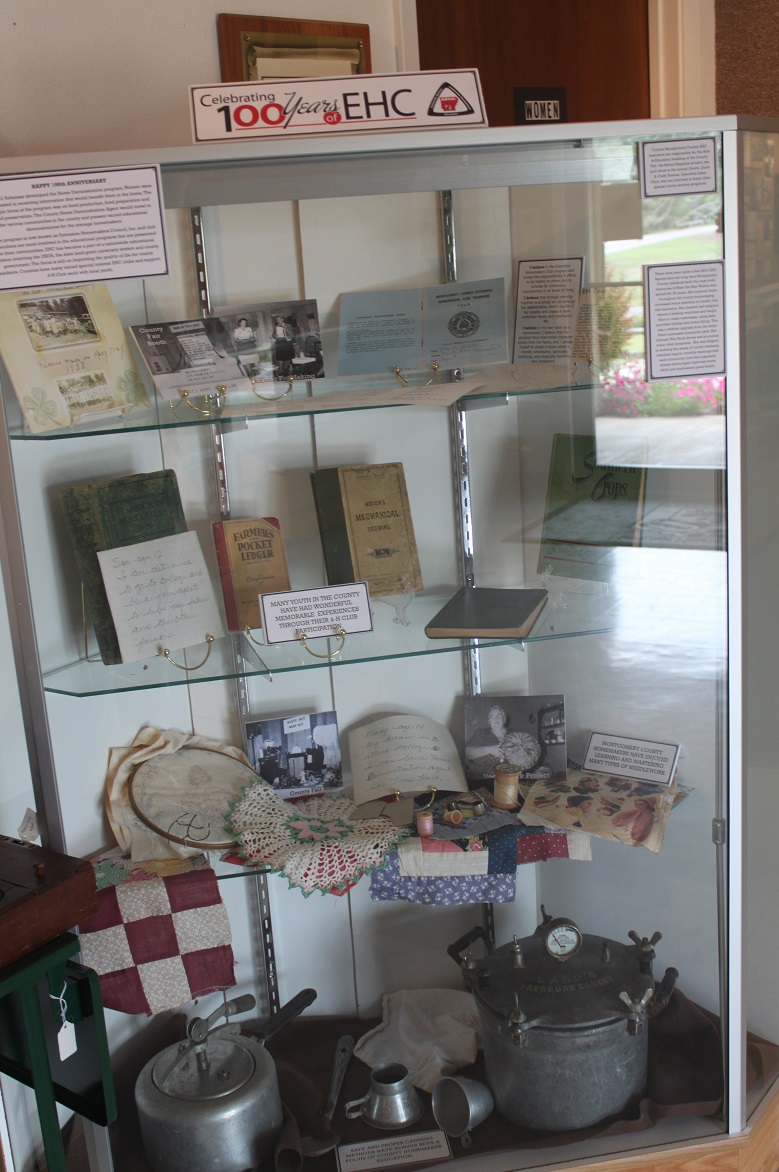
May, age 14, My dream is to attend college. I can be a Home
Demonstration agent like Miss Holt.
Sam -age 12. I am determined to go to college and be a farm agent to
help my father and the other farmers.
Many youth in the county have had wonderful memorable experiences
through their 4 H Club participation.
County Fair Booth
Safe and proper canning methods have always been a focus of county
homemaker education. The County Home Demonstration agent would
travel to the various communities in the county and present varied
educational demonstrations for the average homemaker. The program is
now known as Extension Homemaker Council and club members are more
involved in the educational programs that are presented in their
communications. EHC has become part of a nationwide educational
program involving the USDA, state land grant university system and
county government. The focus is on improving the quality of life for
county members. Counties have many varied special interest EHC clubs
and support 4 H Club work with local youth.
There have been quite a few
EHC agents in Montgomery County. Miss Ola Mae Watson served for
38 years. She was diligent in meeting the needs of the county
members, attended regular monthly meetings with each community club.
Always encouraged improved home skills and emphasized good health.
In 2015 the Staff Chair
County Extension
Agent is Amy Monk and Randy Black the CEA for Agriculture.
Hydrangeas.
Plant database.
Tree ID.
Old museum exhibits from 2003
Grandpa's tools
Tool Shed
Hand powered drill press
Cider Press c. 1890
Office machines
Whittington's portraits
Office
Cabin porch
Quilts
The barn in 2003